National Carry AcademyTHE ULTIMATE GUIDE TO CONCEALED CARRY AMMO
October 1, 2018
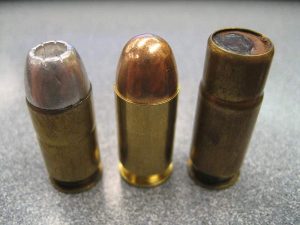
Most shooters struggle with what type of ammo is the best type to buy for their CCW. Pew Pew Tactical published a great article that went into a lot of detail about bullet sizes, calibers, types , components etc.
Bullet Size & Caliber
For guns, “caliber” means the diameter of the barrel and thus the diameter of the bullet that is going through it. Also for terminology sake, “bullet” just means the metal projectile, while the entire thing is called a cartridge.

Parts of a Bullet Cartridge
Rimfire vs Centerfire
The first differentiator is between rimfire and centerfire cartridges.
The rimfire’s primer is built into the rim while the centerfire cartridge has the primer in the center. Rimfires are extremely cheap (few cents each) and the .22LR is the most popular rimfire caliber.
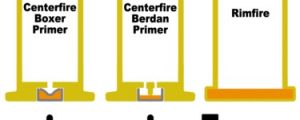
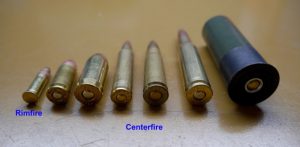
Rimfire vs Centerfire
Common Bullet Calibers
There’s A LOT of bullet calibers, but you might not run into more than a handful in your lifetime. We’ll be going over 18 calibers in total I have on hand, but let’s start with the top 11 most common sizes (in my opinion) first.
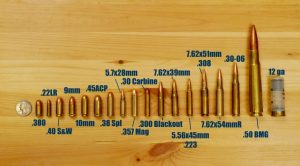
Common Bullet Sizes
To make things a little more confusing, there’s a mixture of measurements in inches and millimeters. There’s also a unit of weight called a “grain” which is used to denote the weight of bullets. A “grain” is really small since 7000 grains make up one pound. When you talk about bullets at this high of a level, the most high level trait is “Stopping Power”.
This is a relatively vague trait and somewhat controversial. What it boils down to is how many bullets does it take to drop a person. Granted, if you hit someone in the right spot it only ever takes one but in most situations you’re aiming for center mass (a.k.a. the chest, a.k.a. the largest target available).
Some bullets have enough power or other traits that will cause damage to organs even if you don’t hit them directly. You might also hear about a term called “Hydrostatic Shock” but that’s an entire article unto itself.
Now let’s go through some!
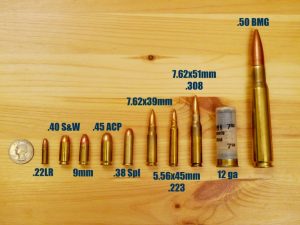
.22LR
The “twenty-two” long-rifle is the most common caliber in terms of units sold.
It has a bullet weight of around 30-40 grains and is extremely mild shooting in both pistols and rifles. The recoil is almost non-existent which makes it a great starter round for someone who has never shot a gun or is uncomfortable with the noise.
The low price of the bullets is also great for learning sight pictures. It is traditionally the starting caliber for shooters. These things are only a few steps up from a pellet gun round.
They can kill, don’t get me wrong, but they’re mostly for killing rats, snakes and birds. They’ll kill an attacker for sure but it might take a shot or six.
I have extremely fond memories of earning my Rifle Shooting merit badge with a .22LR. Many popular handguns and rifles have .22 versions or adapters that let you practice on the platform but use the inexpensive .22LR ammo.
Price: ~ 7 cents
.25 ACP
Slightly larger than the .22 and slightly more powerful….though not much.
The ACP stands for “Automatic Colt Pistol.” There are quite a few guns that use this size but the ammo is more expensive and you’re not getting too much added benefit other than the inherent reliability that comes with center fire casings.
Slightly more stopping power than the .22 but it’s kind of like the difference between stabbing someone with an ice pick or a knitting needle.
Both do the job, but one will leave an ever so slightly larger hole. It’s a tiny round and I’ve yet to use a .25 caliber gun that didn’t work like crap. I’ve used a few flawless .22’s, however. I don’t know why that is.
Price: ~20 cents
.380 ACP
Now we’re getting into the beefy sizes.
Personally, I would never use a gun with anything smaller than a .380 as my primary carry weapon.
Sometimes called a “9mm Short”, it has seen a major boost in popularity recently thanks to the various “pocket pistols” that have come on the market. This is also a very controversial round. If you ever want to troll a gun forum, just go there and ask “which is better: a .380 or a 9mm?” or “Does a .380 have enough stopping power to use it as a carry?” Watch the arguments start.
It’s entertaining.
This bullet has relatively low recoil and, at close range, good penetration.
They’re a great carry weapon size. Gun author Massad Ayoob once said of the .380 “Some experts will say it’s barely adequate, and others will say it’s barely inadequate”. This is a low power round. Because of the nature of the bullet and the guns that shoot it, it’s going to be relatively useless beyond close-ish range.
Price: ~30 cents
9mm
This pistol round is officially known as the “9x19mm Parabellum” or “9mm Luger” to distinguish it from other 9mm rounds, but you will be fine just saying “nine millimeter” or “nine mil” for those in the know.
My personal favorite and if there was a “Goldilocks” round, this would be it.
The very first gun I bought was a 9mm. They’re fun at the range. They’re good for defense.
Believe it or not…or actually believe it because it’s true…the 9mm bullet is the same size as the bullet used in the .380 and the .38 Special. The only difference between the three is the amount of gunpowder behind it.
It is the standard round for NATO countries and the majority of police forces around the world. It is mild shooting, can vary in weight from 115-147 grains, and has varying stopping power based on type of bullet .
The rounds are inexpensive and they have very low recoil. Many, many guns use this size as well. A compact 9mm gun can be used for concealed carry. Most of the guns that use this size can hold on average 15-17 rounds in the magazine.
Price: ~25 cents
.40 S&W
Remember how I said the 9mm was the “Goldilocks Round”? If that’s the case then the .40 is her big, angry, whiskey drinking sister.
Originally designed for the FBI as a reduced 10mm cartridge and popular with other law enforcement agencies ever since. More kick when compared to the other popular handgun cartridge, the 9mm. Weights of the bullet can vary from 155 to 165 and 180 gr. Ammo is still relatively inexpensive.
Note that the FBI recently decided to move back to the 9mm since agents are able to shoot more quickly and more accurately with 9mm compared to the .40 S&W.
Price: ~30 cents
.45 ACP
Designed in 1904 by Mr. John Browning himself for the famous 1911 pistol, this round has one heck of a history.
This thing is a big bullet with stopping power to spare.
The choice of many police officers and military personnel for years, the .45 caliber round has proven itself time and time again. I could probably do an entire article on just this bullet.
It has a large bullet of around 230 grains and has moderate recoil. I can tell you from personal experience that this is not a round to hand to someone who’s never fired a gun before. Its stopping power is renowned and has a nostalgic following. Our recommendations for the best ammo for practice and self-defense.
Price: ~40 cents
.38 Special
The “thirty-eight special” is most commonly found in revolvers.
It has manageable recoil but is still quite a handful when in a very light/small revolver. It has a longer cartridge and more powder in said cartridge but it is a slower, heavier bullet than the 9mm. The FBI used this cartridge as its standard issue for a very long time.
The .357 Magnum is identical to the round except for being slightly longer. You can safely fire a .38 Special in a .357 Magnum gun, but don’t try the other way around due to size and pressure constraints. Bullet weights vary from 110 to 132 to 158 gr.
Price: ~50 cents
7.62x39mm
The Soviet round used in the AK-47 line of rifles. It has moderate recoil, great knockdown power, and a bullet weight of usually 123 grains. There is a high availability of military surplus ammo which makes the round very affordable.
Price: ~20 cents
.223 / 5.56x45mm
The “two-two-three” (inch) Remington has almost the exact dimensions as the “five-five-six” (mm) NATO cartridge.
The 5.56 has higher pressures than the .223, so .223 rounds can be fired in a 5.56 rifle, while 5.56 rounds should not be fired in a .223 rifle. Bullets are around 55 grains and the cartridge has light recoil.
It is the ammunition used in the M16/M4/AR-15 line of rifles and there’s still endless debate on its effectiveness in combat. However for civilian shooters who get the benefit of hollow point ammunition…
Price: ~30 cents
.308 / 7.62x51mm
The “three-oh-eight” (inch) Winchester is almost the same dimensions as the “seven-six-two” (mm) NATO round.
There are special considerations when mixing the rounds but unless you know what you are doing, stick with the round intended for your rifle.
It is a popular hunting round with moderate recoil, high stopping power, and a wide range of bullets available from 150 to 208 grains.
Price: ~75 cents
12 gauge
The most popular shotgun round.
20 gauge is a smaller round while 10 gauge is a much larger round.
Recoil can vary from moderate to high based on round. Shotgun ammunition is the most versatile with birdshot (lots of smaller metal balls), buckshot (fewer much larger metal balls), and slugs (1 oz piece of solid metal). Stopping power is renowned with buckshot and slugs.
Price: ~25 cents for birdshot to $1 for others
.50 BMG
Not really common for civilians, but I just had to have it in here. It’s huge and has huge recoil with awesome range (confirmed kills at 2000m+), and you definitely don’t want to be on the receiving end of the bullet. 660 grains of pure stopping power.
Price: ~$3.00
THE ULTIMATE GUIDE TO CONCEALED CARRY AMMO
October 1, 2018

Most shooters struggle with what type of ammo is the best type to buy for their CCW. Pew Pew Tactical published a great article that went into a lot of detail about bullet sizes, calibers, types , components etc.
Bullet Size & Caliber
For guns, “caliber” means the diameter of the barrel and thus the diameter of the bullet that is going through it. Also for terminology sake, “bullet” just means the metal projectile, while the entire thing is called a cartridge.

Parts of a Bullet Cartridge
Rimfire vs Centerfire
The first differentiator is between rimfire and centerfire cartridges.
The rimfire’s primer is built into the rim while the centerfire cartridge has the primer in the center. Rimfires are extremely cheap (few cents each) and the .22LR is the most popular rimfire caliber.


Rimfire vs Centerfire
Common Bullet Calibers
There’s A LOT of bullet calibers, but you might not run into more than a handful in your lifetime. We’ll be going over 18 calibers in total I have on hand, but let’s start with the top 11 most common sizes (in my opinion) first.

Common Bullet Sizes
To make things a little more confusing, there’s a mixture of measurements in inches and millimeters. There’s also a unit of weight called a “grain” which is used to denote the weight of bullets. A “grain” is really small since 7000 grains make up one pound. When you talk about bullets at this high of a level, the most high level trait is “Stopping Power”.
This is a relatively vague trait and somewhat controversial. What it boils down to is how many bullets does it take to drop a person. Granted, if you hit someone in the right spot it only ever takes one but in most situations you’re aiming for center mass (a.k.a. the chest, a.k.a. the largest target available).
Some bullets have enough power or other traits that will cause damage to organs even if you don’t hit them directly. You might also hear about a term called “Hydrostatic Shock” but that’s an entire article unto itself.
Now let’s go through some!

.22LR
The “twenty-two” long-rifle is the most common caliber in terms of units sold.
It has a bullet weight of around 30-40 grains and is extremely mild shooting in both pistols and rifles. The recoil is almost non-existent which makes it a great starter round for someone who has never shot a gun or is uncomfortable with the noise.
The low price of the bullets is also great for learning sight pictures. It is traditionally the starting caliber for shooters. These things are only a few steps up from a pellet gun round.
They can kill, don’t get me wrong, but they’re mostly for killing rats, snakes and birds. They’ll kill an attacker for sure but it might take a shot or six.
I have extremely fond memories of earning my Rifle Shooting merit badge with a .22LR. Many popular handguns and rifles have .22 versions or adapters that let you practice on the platform but use the inexpensive .22LR ammo.
Price: ~ 7 cents
.25 ACP
Slightly larger than the .22 and slightly more powerful….though not much.
The ACP stands for “Automatic Colt Pistol.” There are quite a few guns that use this size but the ammo is more expensive and you’re not getting too much added benefit other than the inherent reliability that comes with center fire casings.
Slightly more stopping power than the .22 but it’s kind of like the difference between stabbing someone with an ice pick or a knitting needle.
Both do the job, but one will leave an ever so slightly larger hole. It’s a tiny round and I’ve yet to use a .25 caliber gun that didn’t work like crap. I’ve used a few flawless .22’s, however. I don’t know why that is.
Price: ~20 cents
.380 ACP
Now we’re getting into the beefy sizes.
Personally, I would never use a gun with anything smaller than a .380 as my primary carry weapon.
Sometimes called a “9mm Short”, it has seen a major boost in popularity recently thanks to the various “pocket pistols” that have come on the market. This is also a very controversial round. If you ever want to troll a gun forum, just go there and ask “which is better: a .380 or a 9mm?” or “Does a .380 have enough stopping power to use it as a carry?” Watch the arguments start.
It’s entertaining.
This bullet has relatively low recoil and, at close range, good penetration.
They’re a great carry weapon size. Gun author Massad Ayoob once said of the .380 “Some experts will say it’s barely adequate, and others will say it’s barely inadequate”. This is a low power round. Because of the nature of the bullet and the guns that shoot it, it’s going to be relatively useless beyond close-ish range.
Price: ~30 cents
9mm
This pistol round is officially known as the “9x19mm Parabellum” or “9mm Luger” to distinguish it from other 9mm rounds, but you will be fine just saying “nine millimeter” or “nine mil” for those in the know.
My personal favorite and if there was a “Goldilocks” round, this would be it.
The very first gun I bought was a 9mm. They’re fun at the range. They’re good for defense.
Believe it or not…or actually believe it because it’s true…the 9mm bullet is the same size as the bullet used in the .380 and the .38 Special. The only difference between the three is the amount of gunpowder behind it.
It is the standard round for NATO countries and the majority of police forces around the world. It is mild shooting, can vary in weight from 115-147 grains, and has varying stopping power based on type of bullet .
The rounds are inexpensive and they have very low recoil. Many, many guns use this size as well. A compact 9mm gun can be used for concealed carry. Most of the guns that use this size can hold on average 15-17 rounds in the magazine.
Price: ~25 cents
.40 S&W
Remember how I said the 9mm was the “Goldilocks Round”? If that’s the case then the .40 is her big, angry, whiskey drinking sister.
Originally designed for the FBI as a reduced 10mm cartridge and popular with other law enforcement agencies ever since. More kick when compared to the other popular handgun cartridge, the 9mm. Weights of the bullet can vary from 155 to 165 and 180 gr. Ammo is still relatively inexpensive.
Note that the FBI recently decided to move back to the 9mm since agents are able to shoot more quickly and more accurately with 9mm compared to the .40 S&W.
Price: ~30 cents
.45 ACP
Designed in 1904 by Mr. John Browning himself for the famous 1911 pistol, this round has one heck of a history.
This thing is a big bullet with stopping power to spare.
The choice of many police officers and military personnel for years, the .45 caliber round has proven itself time and time again. I could probably do an entire article on just this bullet.
It has a large bullet of around 230 grains and has moderate recoil. I can tell you from personal experience that this is not a round to hand to someone who’s never fired a gun before. Its stopping power is renowned and has a nostalgic following. Our recommendations for the best ammo for practice and self-defense.
Price: ~40 cents
.38 Special
The “thirty-eight special” is most commonly found in revolvers.
It has manageable recoil but is still quite a handful when in a very light/small revolver. It has a longer cartridge and more powder in said cartridge but it is a slower, heavier bullet than the 9mm. The FBI used this cartridge as its standard issue for a very long time.
The .357 Magnum is identical to the round except for being slightly longer. You can safely fire a .38 Special in a .357 Magnum gun, but don’t try the other way around due to size and pressure constraints. Bullet weights vary from 110 to 132 to 158 gr.
Price: ~50 cents
7.62x39mm
The Soviet round used in the AK-47 line of rifles. It has moderate recoil, great knockdown power, and a bullet weight of usually 123 grains. There is a high availability of military surplus ammo which makes the round very affordable.
Price: ~20 cents
.223 / 5.56x45mm
The “two-two-three” (inch) Remington has almost the exact dimensions as the “five-five-six” (mm) NATO cartridge.
The 5.56 has higher pressures than the .223, so .223 rounds can be fired in a 5.56 rifle, while 5.56 rounds should not be fired in a .223 rifle. Bullets are around 55 grains and the cartridge has light recoil.
It is the ammunition used in the M16/M4/AR-15 line of rifles and there’s still endless debate on its effectiveness in combat. However for civilian shooters who get the benefit of hollow point ammunition…
Price: ~30 cents
.308 / 7.62x51mm
The “three-oh-eight” (inch) Winchester is almost the same dimensions as the “seven-six-two” (mm) NATO round.
There are special considerations when mixing the rounds but unless you know what you are doing, stick with the round intended for your rifle.
It is a popular hunting round with moderate recoil, high stopping power, and a wide range of bullets available from 150 to 208 grains.
Price: ~75 cents
12 gauge
The most popular shotgun round.
20 gauge is a smaller round while 10 gauge is a much larger round.
Recoil can vary from moderate to high based on round. Shotgun ammunition is the most versatile with birdshot (lots of smaller metal balls), buckshot (fewer much larger metal balls), and slugs (1 oz piece of solid metal). Stopping power is renowned with buckshot and slugs.
Price: ~25 cents for birdshot to $1 for others
.50 BMG
Not really common for civilians, but I just had to have it in here. It’s huge and has huge recoil with awesome range (confirmed kills at 2000m+), and you definitely don’t want to be on the receiving end of the bullet. 660 grains of pure stopping power.
Price: ~$3.00
